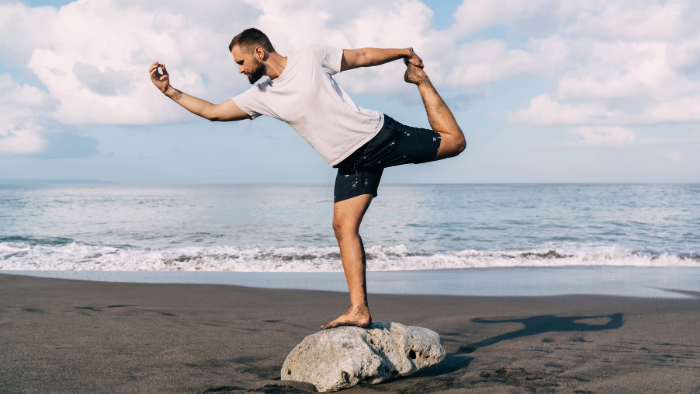Neck Strength: Protecting Your Head from Fall-Related Injuries
Essential Points:
Neck Strength Reduces Fall-Related Head Injuries: Strengthening your neck acts as a natural shock absorber, helping to minimize the risk of traumatic brain injuries (TBIs) by stabilizing your head during falls and preventing excessive whiplash or direct impacts.
Simple Exercises for a Resilient Neck: Incorporate basic movements like neck rotations, isometric holds, and chin tucks to improve neck stability and control. These exercises are easy to perform at home and can be adapted for increasing difficulty.
Comprehensive Fall Prevention Strategy: While neck strength is essential, combine it with balance training, safe falling techniques, and home safety measures for maximum protection against falls and related injuries.
Falls are one of the leading causes of traumatic brain injuries (TBIs), especially among older adults. It’s a sobering reality, but the good news is that there are proactive steps you can take to protect yourself.
One often overlooked strategy? Strengthening your neck. A strong neck isn’t just for athletes or gym buffs, it’s a vital tool for preventing head injuries during falls. In this short article we will explore why neck strength matters, how it helps, and what you can do to build a more resilient neck.
Understanding Basic Anatomy of the Neck
Before diving into the “how,” let’s take a quick look at the “what.” Your neck is more than just a passageway connecting your head to your torso. It’s a complex structure that plays a critical role in head stabilization and movement.
The Cervical Spine
The neck houses many structures including the cervical spine, the uppermost section of your spinal column. (1) It consists of seven bony vertebrae (C1-C7), which support the head and allow for its incredible range of motion. These vertebrae are cushioned by intervertebral discs that absorb shock and provide flexibility for movement in all directions. These structures are passive in nature and are not under your control, unlike your muscles.
Key Neck Muscles for Fall Injury Prevention
Movement of the cervical spine doesn’t happen on its own. The vertebrae and discs require specialized musculature to allow varying levels of stabilization and movement depending on the situation. (1) Although there are approximately twenty muscles in your neck, we want to focus on just a few for our purposes:
Sternocleidomastoid: This muscle is responsible for turning your head and tilting it to the side when used unilaterally (on one side of the neck). When used bilaterally (on both sides of the neck), it enables forward neck flexion and provides additional stability.
Deep Cervical Flexors: These small but mighty muscles stabilize the spine and are essential for forward head motion and chin tucking. During unilateral activation, they help in fine-tuned adjustments for asymmetric movements. Bilaterally, they ensure stability and support for balanced, forward head movements.
Supporting Neck Structures for Fall Injury Prevention
Along with the vertebrae, discs and muscles the neck contains many more structures. Ligaments, tendons, and the spinal cord all contribute to neck stability or bodily function, although we wont be diving in too deep on these structures here. Together, these structures help distribute forces during sudden impacts in their own unique ways making them essential for head protection.
Falls and TBIs: The Risk is Real
Falls are a leading cause of TBI related hospitalizations, accounting for nearly half of all cases in the United States, according to the CDC. (2) Older adults are particularly vulnerable, with falls being a top reason for emergency room visits and hospitalizations. (3) While hitting your head during a fall isn’t always avoidable, the strength of your neck can play a pivotal role in minimizing injury related to TBI, especially when falling backwards. (4, 5)
The Mechanics of a Fall and Head Injury
When you lose balance, your body’s natural reaction is to brace and adjust muscular forces for protection as needed. (6) Your subconscious goal is to either prevent a fall, or prepare for one. However, without adequate neck strength during a fall, the head can easily whip backwards uncontrollably and hit the ground. This can lead to:
Whiplash-like movements that strain the neck.
Reduced control over head stabilization.
Direct impact injuries to the skull.
How a Strong Neck Helps Prevent Head Injury During a Fall
A strong neck acts as a braking system and shock absorber, reducing the whiplash effect and helping you control head movements during a fall to prevent hitting the ground. Studies have shown that individuals with greater neck strength are less likely to sustain severe head injuries in high-impact situations, such as sports collisions. (7, 8) The same principle applies to falls as they are simply unplanned high-impact collisions with the ground.
Neck Strengthening: A Key to Fall Injury Prevention
You don’t need a gym membership or fancy equipment to strengthen your neck. With a few simple exercises, you can improve your overall neck’s resilience and reduce your risk of head injury during falls. Let’s start with the basics.
Guidelines for Safe Neck Training and Strengthening
Before you learn about a few key neck exercises, here are some principles of neck training for the most benefit:
Start Light: Use bodyweight or light resistance to avoid strain.
Focus on Form: Proper neck alignment is crucial to prevent injury. Focus on maintaining proper form at all times and cease the exercise when form is unable to be maintained.
Consistency is Key: Aim for 2-3 sessions per week. Add on as a warm-up or cool-down to your pre-existing exercise plan.
Effective Neck Exercises For Fall Safety Preparation
Neck Rotations:
This exercise helps maintain full range of motion of your neck to increase movement options available to your during a fall.
Slowly turn your head to the right as far as comfortable, then to the left.
Perform 10 repetitions on each side.
Can be used as a warm-up prior to other neck exercises.
Isometric (Non-moving) Neck Exercises:
This exercise targets your neck’s overall ability to reduce force in all directions.
Place one (or both) of your hands against your forehead and gently push while resisting with your neck muscles. No movement shoulder occur, but you should feel as if you are working hard.
Hold for 5-10 seconds. Repeat 6 times for a total of up to 1 minute of work in each direction of pushing.
Perform with hands on:
Forehead (Flexion of neck)
Sides of head (Sideways tilting of head)
Back of head (Extension of head)
Temples (Rotation of head)
Chin Tucks:
This exercise targets your ability to tuck your chin and create space away from the ground during a fall.
Sit or stand with your back straight.
Gently tuck your chin, or slide the chin backwards, toward your chest without bending your neck.
You should look as if you have a double chin if you are performing the exercise correctly.
As a mental image, think of sliding your chin backwards on a table instead of looking downwards.
Hold for 5-10 seconds and repeat 6 times for a total of 1 minute work
Tips for increasing difficulty:
Standing and sitting will give very little resistance in this exercise but are good places to start to learn form
If you are ready for a challenge, perform exercise lying down face up.
Lift head 1” off of surface while keeping chin tucked. Hold, with good form, as long as possible.
Additional Tips for Protecting Your Head During Falls
While neck strength is a valuable tool, it’s just one part of a comprehensive fall prevention strategy. Here are additional steps to safeguard against head injuries during or before falls:
Improve Your Balance: Regular balance training can reduce the likelihood of falls before the ever happen. Check out our Beginner to Intermediate Balance Program for step-by-step custom guidance to bulletproof your balance.
Learn Safe Falling Techniques: Techniques like rolling can help minimize impact on the head and body as a whole. Read more about the origins of my preferred falling style “parkour ukemi” or start your journey of learning falling techniques through my video tutorials to drastically reduce your chance of injury in a fall.
Wear Protective Gear: If you’re at high risk of falls, consider using helmets or padded headgear during activities like biking or skiing. Or if you are keen to investigate protective gear for everyday wear check out this article on the new world of wearable falling airbags.
Maintain a Safe Environment: Remove tripping hazards, improve lighting, and use non-slip mats at home.
Final Thoughts: Keep Your Head in the Game
Your neck might not be the first thing you think of when it comes to fall prevention, but it’s a key player in protecting your head and reducing the risk of serious injuries like TBIs. By incorporating simple neck exercises into your routine and taking additional safety precautions, you can build a more resilient body and reduce your risk of fall-related injuries.
Start building your neck, balance, and falling skills today! Remember, small actions performed consistently can make a big difference in your long-term health and independence.
Stay strong, stay balanced, and stay safe!
References
Anatomy, head and neck: cervical spine. PubMed. Published January 1, 2024. https://pubmed.ncbi.nlm.nih.gov/32491448/
Facts about TBI. Traumatic Brain Injury & Concussion. Published April 29, 2024. https://www.cdc.gov/traumatic-brain-injury/data-research/facts-stats/index.html#:~:text=People%20most%20commonly%20get%20TBIs,9
Facts about falls. Older Adult Fall Prevention. Published May 9, 2024. https://www.cdc.gov/falls/data-research/facts-stats/index.html
Eckner JT, Oh YK, Joshi MS, Richardson JK, Ashton-Miller JA. Effect of neck muscle strength and anticipatory cervical muscle activation on the kinematic response of the head to impulsive loads. The American Journal of Sports Medicine. 2014;42(3):566-576. doi:10.1177/0363546513517869
Wood TA, Sosnoff JJ. Age-related differences to neck range of motion and muscle strength: potential risk factors to fall-related traumatic brain injuries. Aging Clinical and Experimental Research. 2019;32(11):2287-2295. doi:10.1007/s40520-019-01429-7
Danna-Dos-Santos A, Degani AM, Latash ML. Anticipatory control of head posture. Clinical Neurophysiology. 2007;118(8):1802-1814. doi:10.1016/j.clinph.2007.05.060
Toninato J, Casey H, Uppal M, et al. Traumatic brain injury reduction in athletes by neck strengthening (TRAIN). Contemporary Clinical Trials Communications. 2018;11:102-106. doi:10.1016/j.conctc.2018.06.007
Garrett JM, Mastrorocco M, Peek K, Van Den Hoek DJ, McGuckian TB. The Relationship Between Neck Strength and Sports-Related Concussion in Team Sports: A Systematic Review with Meta-analysis. Journal of Orthopaedic and Sports Physical Therapy. 2023;53(10):585-593. doi:10.2519/jospt.2023.11727









